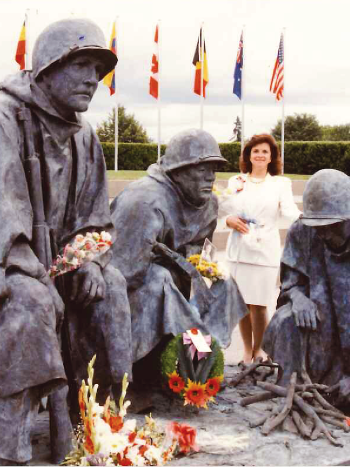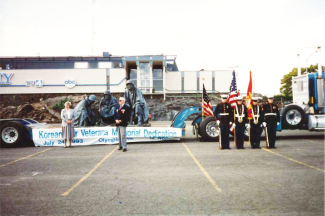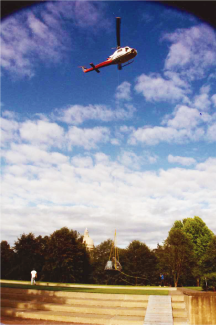The unique journey of the Korean War Memorial

How the East Campus’ only memorial arrived at the Washington state capitol.
Like the conflict it commemorates, the state capitol’s Korean War Memorial stands apart.
It’s the only monument sited on the East Capitol Campus, the mid-twentieth-century extension of the original, historic West Capitol Campus and its focal point, the Legislative Building.
Just steps from that building and its iconic dome, the fresh-faced figures of the Winged Victory monument stride eastward, rifles bright and packs full, toward the battlegrounds of the First World War.
Several hundred yards away, the only monument on the East Capitol Campus tells a different story.
Two of its three figures are occupied with igniting a meager, rain-soaked pile of sticks for warmth. The third stares bleakly into the distance. Their postures speak of “the lonely, cold, painful cost of war,” said memorial sculptor Deborah Copenhaver Fellows at the bronze’s 1993 unveiling.
The memorial stands apart in a third way. It traveled a very different path to its final place of honor: a long and roundabout journey, with a unique final leg.

From the Montana studio where they were forged, the bronze figures were loaded onto the back of a flatbed truck. The truck didn’t head directly to its final destination—instead, it exhibited its cargo in seven communities: Spokane, Pasco, Wenatchee, Seattle, Tacoma, Silverdale, and Aberdeen.
People across the state had participated in raising funds for the memorial, says Adolfo Capestany, former public affairs manager for the state Department of Veterans Affairs. Capestany oversaw the construction and fundraising for the memorial. He says they made these stops with donors in mind, reasoning that the veterans of the 40-year-old war might not be able to travel to the dedication ceremony.
Once the truck arrived in Olympia, the statue’s land-based journey was complete. A new chapter was about to begin.
Rather than the solid ground beneath the stone pedestal of Winged Victory, these bronze figures were destined for a landscaped plaza that also serves as the rooftop of a parking structure. Planners knew that the rooftop would hold the weight of the bronze—but not of a heavy crane.
Without a crane, there was no earthly way to move the statue into place. So the state commissioned a helicopter.

Bryan Reynolds, CEO of Northwest Helicopters, remembers managing the statue’s flight. The landing site was small: concrete pedestals for informational signs had been poured. Reynolds arranged for one of his best pilots, Paul Bryant, to fly it into place. Bryant landed the bronze figures right on target.
After months of paperwork with the City of Olympia and the Federal Aviation Administration, the airborne stage of the figures’ journey took five minutes.
Weeks later—32 years ago this month—state officials dedicated the memorial before a gathering of 3,500 people.
The dedication was a landmark in Capestany’s career, marking the culmination of years of work with veterans groups who did the grassroots fundraising, from Spokane to Aberdeen, that made the memorial possible. The experience informed his subsequent work to renovate the Vietnam Veterans Memorial and create the campus’ memorial to World War II.
In the 32 years since, Reynolds hasn’t had the chance to move another bronze figure. And in artist Deborah Fellows’ half century of work, the bronze is her only piece to be installed by helicopter.
More information
Sign up for a tour of the capitol’s memorials
Contact Us
DES Communications
media@des.wa.gov
360-407-9300

